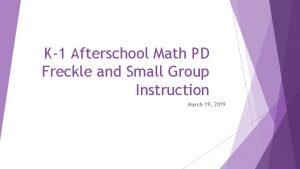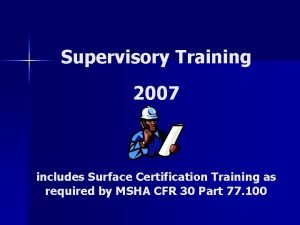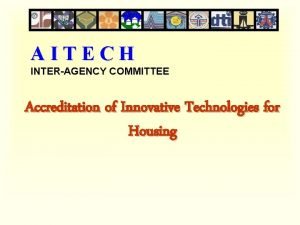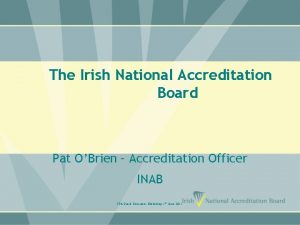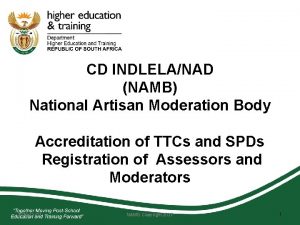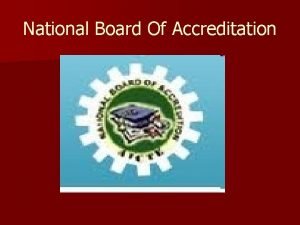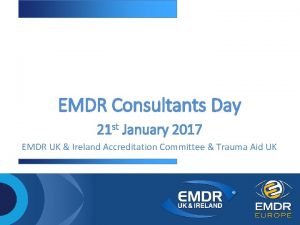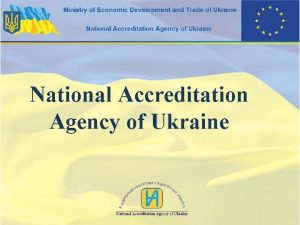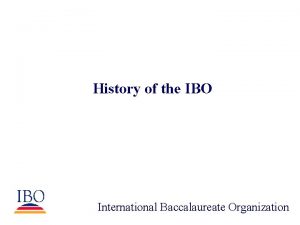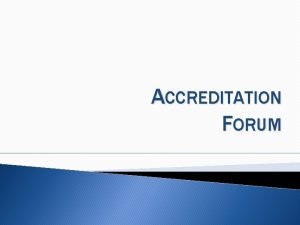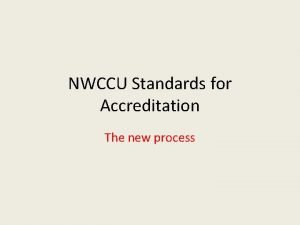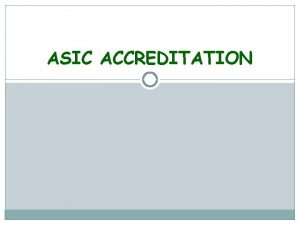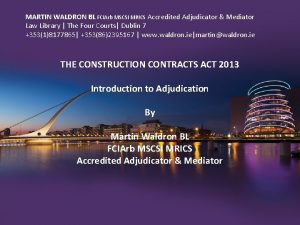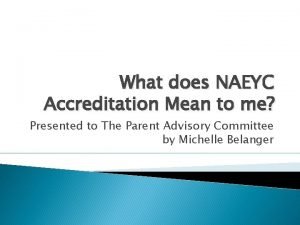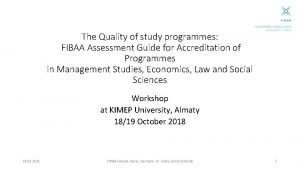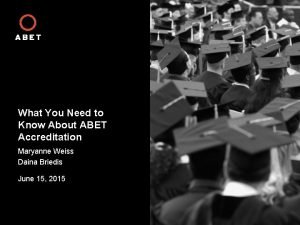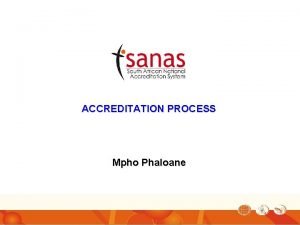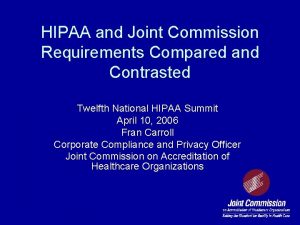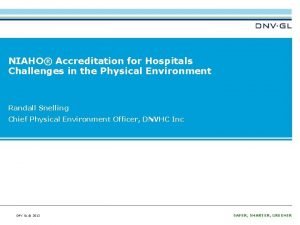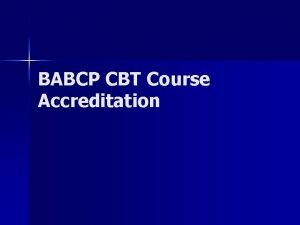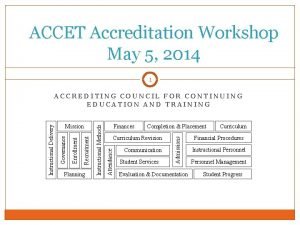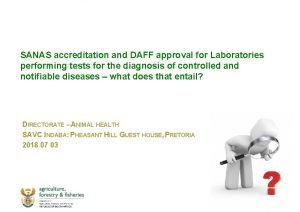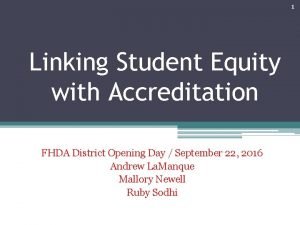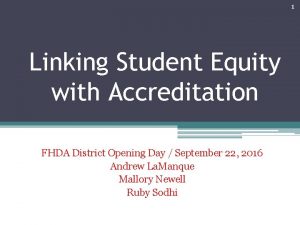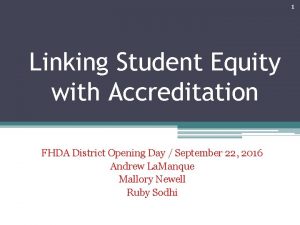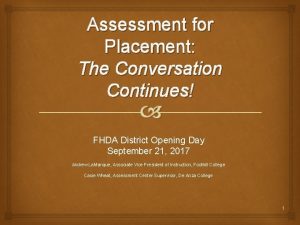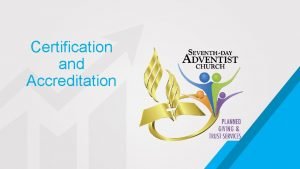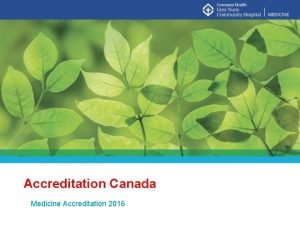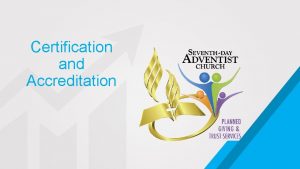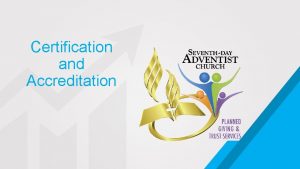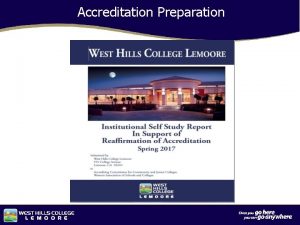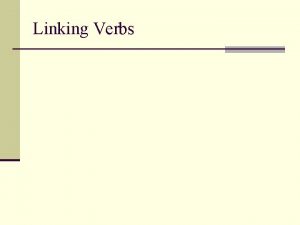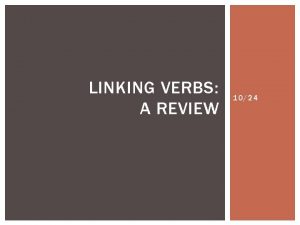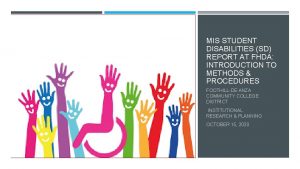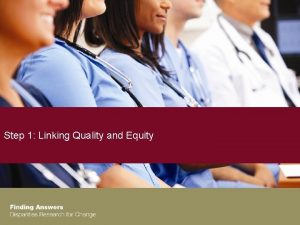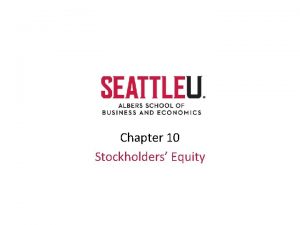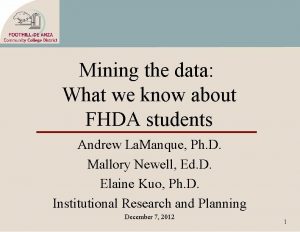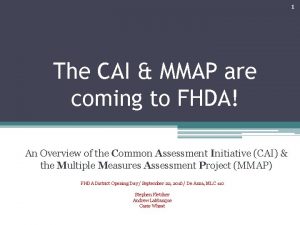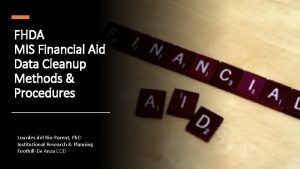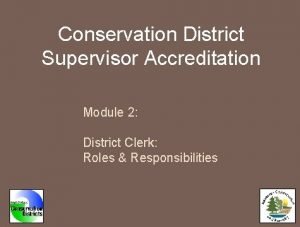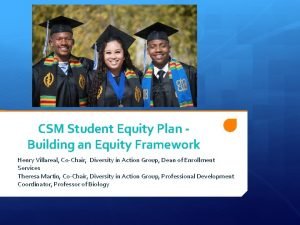1 Linking Student Equity with Accreditation FHDA District

































- Slides: 33

1 Linking Student Equity with Accreditation FHDA District Opening Day / September 22, 2016 Andrew La. Manque Mallory Newell Ruby Sodhi

2 Goals • Develop an understanding of how equity is included in the accreditation Standards. • Develop knowledge of the potential relationship between equity and program review and accreditation. • Develop an understanding of how an equity agenda can be incorporated into the Quality Focus Essay (QFE).

3 Activity #1 • Are you participating in the Self Study process? • Are you working on equity activities at your college? • Were you aware that the Self Study process now includes a QFE?

4 Accreditation: Voluntary System of Self-Regulation Six Year Cycle (next time 7) Peer Review – Evaluation Team Visit Self-Study – Institution Evaluates Attainment of Standards Recommendatio n from the Accrediting Commission for Community and Junior Colleges (ACCJC)

5 Purposes of Accreditation Promotes Institutional Improvement Source: adapted from http: //www. chea. org/ Assures Institutional Quality to Taxpayers Certifies Value and Legitimacy of Student Award

6 Accreditation Standards Updated June 2014 Standard 1: Mission, Academic Quality and Institutional Effectiveness and Integrity A. Mission B. Academic Quality and Institutional Effectiveness C. Institutional Integrity Standard 2: Student Learning Programs and Support Services A. Instructional Programs B. Library and Learning Support Services C. Student Support Services Standard 3: Resources A. Human Resources B. Physical Resources C. Technology Resources D. Financial Resources Standard 4: Leadership and Governance A. Decision-Making Roles and Processes B. Chief Executive Office C. Governing Board D. Multi-College Districts Note: Self Study now requires a Quality Focused Essay (QFE).

7 Foothill Recommendations 2011

8 De Anza Recommendation 2011 Recommendation 3 To meet the standard at the level of proficiency by 2012, the team recommends that the college accelerate the implementation of the SLO, SSLO, and AUO assessment cycles at the course, program and institutional levels. The college should assess the effectiveness of these processes aimed at improving programs, services, and student learning. Additionally, the college is reminded that the standard requires accredited institutions to include “effectiveness in producing Learning outcomes” in the evaluation of faculty and others directly responsible for student progress toward achieving stated student learning outcomes.

9 What does equity mean?

10 CCC Chancellor's Office Definition of Equity For purposes of this plan, student equity is defined as helping students achieve equal outcomes on success indicators as compared to either their own percentage in the community or college student body, or to other student groups.

11 Student Equity Plan Success Indicators Access Course Success/ Completion ESL, Math, English Basic Skills Completion Transfer Degree and Certificate Completion

12 Foothill College Mission Statement Believing a well educated population is essential to sustaining and enhancing a democratic society, Foothill College offers programs and services that empower students to achieve their goals as members of the workforce, as future students and as global citizens. We work to obtain equity in achievement of student outcomes for all California student populations, and are guided by our core values of honesty, integrity, trust, openness, transparency, forgiveness, and sustainability.

13 Foothill Educational Master Plan Goals These goals are approached in a way that exemplifies Foothill College’s culture of innovation and problem solving, with emphasis on eliminating disproportionate impact among student groups: • Create a culture of equity that promotes student success, particularly for underserved students. • Strengthen a sense of community and commitment to the College’s mission; expand participation from all constituencies in shared governance. • Recognize and support a campus culture that values ongoing improvement and stewardship of resources.

14 De Anza College Mission Statement De Anza College provides an academically rich, multicultural learning environment that challenges students of every background to develop their intellect, character and abilities; to realize their goals; and to be socially responsible leaders in their communities, the nation and the world. The college engages students in creative work that demonstrates the knowledge, skills and attitudes contained within the college’s Institutional Core Competencies: • Communication and expression • Information literacy • Physical/mental wellness and personal responsibility • Civic capacity for global, cultural, social and environmental justice • Critical thinking

15 De Anza’s Strategic Initiatives Ø Outreach Ø Individualized Attention to Student Retention and Success Ø Equity Ø Community and Civic Engagement Educational Master Plan, 2015 2020

De Anza’s Equity Framework 16 De Anza Educational Master Plan, 2015 2020

17 De Anza’s Equity-Driven Change Model Rubric

18 Activity #2 • How could you apply an equity framework and/or the equity rubric to evaluate your own program area?

19 ACCJC Standards That Explicitly Mention Equity • I. B. 1. The institution demonstrates a sustained, substantive and collegial dialog about student outcomes, student equity, academic quality, institutional effectiveness, and continuous improvement of student learning and achievement. • II. A. 7. The institution effectively uses delivery modes, teaching methodologies and learning support services that reflect the diverse and changing needs of its students, in support of equity in success for all students. • III. A. 12. Through its policies and practices, the institution creates and maintains appropriate programs, practices, and services that support its diverse personnel. The institution regularly assesses its record in employment equity and diversity consistent with its mission.

20 Equity in the context of the Standards includes: • Academic quality • Student services • Human resources practices • Disaggregation of student learning outcomes data

21 Quality Focus Essay Requirements • Identify 2 3 areas for further study, improvement, and to enhance academic quality, institutional effectiveness, and excellence �Stemming from the action plans and become "action projects“ �Focus on improving learning and achievement • Discuss in detail the identified areas to be acted upon, responsible parties, timeline, anticipated outcomes, and the impact on academic quality and institutional effectiveness. � 5, 000 word limit • Action projects become multi year, long term directions for improvement and commitment to excellence �Focal point for the Midterm Report

22 QFE Example – Chaffey College • Goal 3 (G 3): Create new supports and interventions to close the achievement gap for all disproportionally affected groups (students, staff, faculty, and administrators). • Objective 1 (G 3. O 1): • Identify and explore the institutional barriers hindering equity ▫ Create opportunities for open and regular dialog about issues hindering equity ▫ Create a core competency explicitly addressing equity

23 QFE – City College of San Francisco Action Project 2. The action project to close achievement gaps in Basic Skills is taken from the “ESL and Basic Skills Completion” section of the College’s 2015 16 Student Equity Plan. The College chose this project for two reasons. First, the Basic Skills portion of the Equity Plan focuses on making lasting institutional level changes to the delivery of basic skills that have the potential to benefit students beyond the life of the grant funds. Second, the College is hoping to add SLO data to equity planning, and pursuing this project has the potential to help the College identify the best ways to combine SLO and achievement data to close achievement gaps. • Building an ESL Mission Pathway that increases the number of underrepresented minority students who move from noncredit ESL to credit coursework (certificate, degree, or transfer programs) • Expanding English Sequence Acceleration to increase the number of all students completing the English basic skills sequence • Creating a Developmental Math Community of Practice that closes achievement gaps through a community of practice that draws on and translates experiences from a Summer Math Academy for African American, Latino, Pacific Islander, and Native American students

24 QFE– Santa Monica College Action Project Related Plans for improvement emerging from self- Standards evaluation Integrated Student To reduce equity gaps in student achievement as IIA 3 Equity and Success identified in Student Equity Plan, Program Review, IIA 8 Plan and Institutional Effectiveness reports Reduce time to completion of academic goals IIA 5 Ongoing implementation and assessment of Student IIA 7 Equity Plan Use contextualized instruction and other evidencebased methods from the Basic Skills Innovation and IIA 11 Transformation project to improve success Hire a diverse faculty and staff that reflects the SMC IIIA 10 student population Prioritize the Student Equity and Success plan in the IVA 1 new strategic planning cycle to be initiated in Fall 2016 Research, implement, and evaluate a single tutoring tracking and assessment system college-wide IIB 3

25 QFE Discussion Item Institutional Core Competency: My experience at this college contributed to my ability to solve numerical problems. Very much/ Quite a bit Percent Some/ Very little/ Don’t know Percent Total Targeted 187 68% 87 32% 264 Not Targeted 518 59% 364 41% 829 Institutional Core Competency: My experience at this college contributed to my ability to use computing and information technology. Very much/ Quite a bit Percent Some/ Very little/ Don’t know Percent Total Targeted 174 63% 100 36% 274 Not Targeted 535 60% 353 39% 888

26 Activity #3 • What do these data tell you? • What questions/interpretations/assumptions emerge from these data? • What other information might be helpful? • What groups would you want to consult with? • Based on these data, what types of activities might you propose for the QFE? • What should our goals be? • Who (people, departments) should be involved?

27 The Role of Program Review in Accreditation • Mentioned in several Standards • Part of an integrated planning process • Connects college goals to student learning (course and program outcomes) • Might include institutional and program standards for student achievement (a minimum or floor).

28 Foothill’s Program Review Template 1 G. Equity: One of the goals of the College’s Student Equity plan is to close the performance gap for disproportionately impacted students, including African ‐American, Hispanic/Latino, and Filipinos/Pacific Islanders. If the course success rates for these students (or other groups not listed above, such as foster youth, veterans, and students with disabilities) is below that of the College, what is your program doing to address this?

29 De Anza’s Program Review Prompts 1. What progress or achievement has the program made relative to the plans stated in your program’s Comprehensive Program Review towards decreasing the student equity gap? 2. What progress or achievement has the program made relative to the plans stated in your departmental Equity Plan?

30 Sample Program Review Response: Fhdaeology Department Our online classes are the most in need of more tutorial services but that is a college wide problem, which has yet to be systematically addressed. We have had success and improved results in objective online tests by opening the testing window from one hour to two ‐three hours.

31 Activity #4 – Providing Constructive Feedback on the Equity Agenda of Fhdaeology Department • What additional data or information would be helpful for you to see? • What suggestions would you give to this department? • What resources might they request? • What might you see in their program outcomes disaggregated by online/face to face?

32 Summary – did we help you … • Develop an understanding of how equity is included in the accreditation Standards? • Develop knowledge of the potential relationship between equity, program review, and accreditation? • Develop an understanding of how an equity agenda can be incorporated into the Quality Focus Essay (QFE)?

33 Questions
 Dynamic picture
Dynamic picture Granite schools gradebook
Granite schools gradebook Student learning space helpdesk
Student learning space helpdesk Tell me about your last weekend
Tell me about your last weekend National student clearinghouse student tracker
National student clearinghouse student tracker What did they do last weekend
What did they do last weekend Freckle.student.com
Freckle.student.com National student clearinghouse student tracker
National student clearinghouse student tracker Good morning students images
Good morning students images Class maths student student1 class student string name
Class maths student student1 class student string name Niaho
Niaho Surface supervisor accreditation
Surface supervisor accreditation Aitech accreditation
Aitech accreditation National accreditation board
National accreditation board Indlela trade centre
Indlela trade centre National board for accreditation
National board for accreditation Emdr uk accreditation
Emdr uk accreditation National accreditation agency of ukraine
National accreditation agency of ukraine John goormaghtigh net worth
John goormaghtigh net worth National board of accreditation questions and answers
National board of accreditation questions and answers Nwccu standards
Nwccu standards Asic accreditation
Asic accreditation Martin waldron bl
Martin waldron bl Naeyc stands for
Naeyc stands for Fibaa accreditation
Fibaa accreditation Abet headquarters
Abet headquarters What is sanas
What is sanas Joint commission accreditation standards
Joint commission accreditation standards Niaho accreditation
Niaho accreditation Bac british accreditation council
Bac british accreditation council Babcp accreditation
Babcp accreditation Accet accreditation requirements
Accet accreditation requirements Ccd radiology
Ccd radiology Sanas accreditation process
Sanas accreditation process






